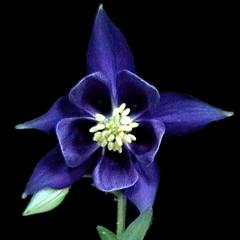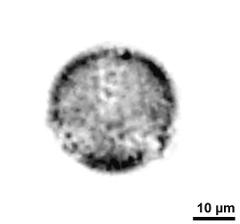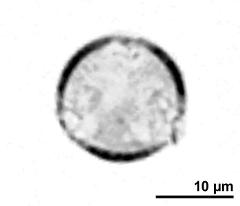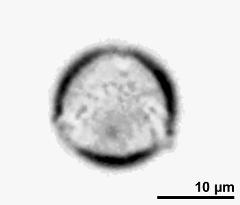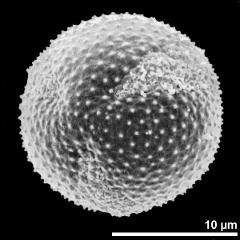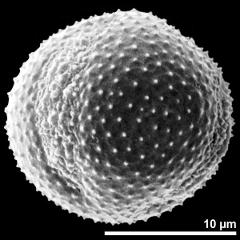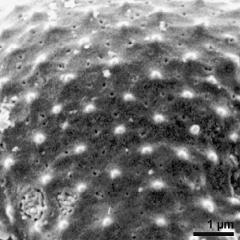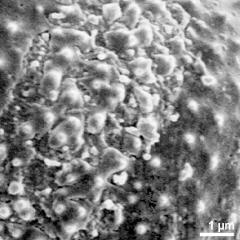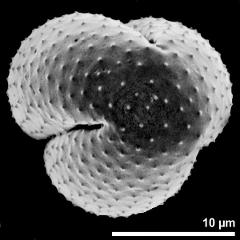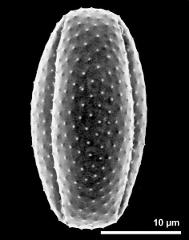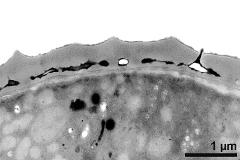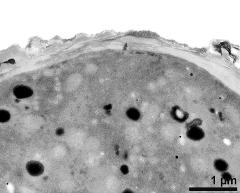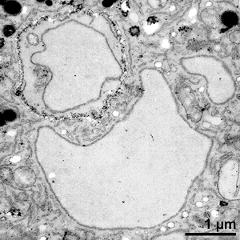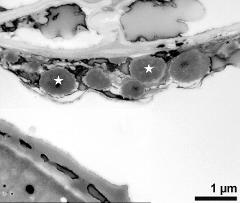Aquilegia vulgaris
Taxonomy: Spermatophyta, Ranunculales, Ranunculaceae, Aquilegia
Published: 2005-06-01
Pollen Description
Shape, Size and Aperture
pollen unit: monad, dispersal unit and peculiarities: monad, size (pollen unit): small (10-25 µm), size of hydrated pollen (LM): -, shortest polar axis in equatorial view (LM): -, longest polar axis in equatorial view (LM): -, shortest diameter in equatorial or polar view (LM): -, longest diameter in equatorial or polar view (LM): -, pollen class: -, polarity: isopolar, P/E-ratio: -, shape: spheroidal, outline in polar view: circular, dominant orientation (LM): -, P/E-ratio (dry pollen): prolate, shape (dry pollen): -, outline in polar view (dry pollen): lobate, infoldings (dry pollen): aperture(s) sunken, aperture number: 3, aperture type: -, aperture condition: colpate, aperture peculiarities: aperture membrane ornamented
Ornamentation and Structure
LM ornamentation LM: psilate, nexine: -, sexine: -, SEM ornamentation SEM: microechinate, perforate, suprasculpture SEM: -, TEM tectum: eutectate, infratectum: columellate, foot layer: discontinuous, endexine: compact-continuous, intine: monolayered, wall peculiarities: -, supratectal element: -
Miscellaneous
pollen coatings: pollenkitt, reserves in cytoplasm: starch, lipids, cell number: 2-celled, Ubisch bodies: present
Author(s) of diagnosis: Oberschneider, W.
Pictures
Picture legend
- flower(s), photographer: Oberschneider, W.
- upper focus - fresh, acetolyzed, unstained, photographer: Oberschneider, W.
- optical section - fresh, acetolyzed, unstained, photographer: Oberschneider, W.
- lower focus - fresh, acetolyzed, unstained, photographer: Oberschneider, W.
- polar view - fresh, rehydration (water) & chloroform & critical point dried & sputter coated with gold, photographer: Oberschneider, W.
- equatorial view - fresh, rehydration (water) & chloroform & critical point dried & sputter coated with gold, photographer: Oberschneider, W.
- exine surface - fresh, rehydration (water) & chloroform & critical point dried & sputter coated with gold, photographer: Oberschneider, W.
- detail of aperture - fresh, rehydration (water) & chloroform & critical point dried & sputter coated with gold, photographer: Oberschneider, W.
- polar view of dry pollen grain - dry, sputter coated with gold, photographer: Oberschneider, W.
- dry pollen grain in equatorial view - dry, sputter coated with gold, photographer: Oberschneider, W.
- pollen wall - fresh, glutaraldehyde & osmium & potassium ferrocyanide, uranyl acetate & lead citrate, photographer: Oberschneider, W.
- aperture - fresh, glutaraldehyde & osmium & potassium ferrocyanide, uranyl acetate & lead citrate, photographer: Oberschneider, W.
- vegetative nucleus and generative cell (top) - fresh, glutaraldehyde & osmium & potassium ferrocyanide, modified Thiéry-test, photographer: Oberschneider, W.
- pollen wall (left) and tapetum cells with Ubisch bodies (asterisks) - fresh, glutaraldehyde & osmium & potassium ferrocyanide, uranyl acetate & lead citrate, photographer: Oberschneider, W.
Literature
- (1983) Studies in the pollen morphology of some cultivated Angiosperms Adv Pollen - Spore Res 11: 67 pp, 13 pl, 51 figs
- (1842) Memoir to determine the use of pollen in natural classification. J Bot 1: 575-601
- (1984) A practical pollen guide to the British flora. Quaternary Res Bull Technical Guide I: 1-139
- () Pollenformen und Honigherkunftbestimmung. Bücher des Archivs für Bienenkunde, Berlin 2: 1-122
- (1986) Claves para la determinación de los polenes de las principales especies melíferas de la Península Ibérica. Orsis 2: 27-54
- (1988) Palinología de plantas endémicas del Sureste de la Península Ibérica. In: Civis Llovera J., Valle Hernández M.F. (eds) Actas de Palinología (Actas del VI Simposio de Palinología, A.P.L.E., Salamanca, 1986) : 23-28
- (1991) The Northwest European Pollen Flora, 51. Ranunculaceae. Rev Palaeobot Palynol 69: 117-271
- (1877) Pollen. Hardwicke & Bogue, London : 92 pp, 24 pl
- (1964) Text book of pollen analysis. Scandinavian University Books, Munksgaard : 1-237
- (1986) Contribución al conocimiento palinológico de la familia Ranunculaceae en Andalucía. II. Subfam. Ranunculoideae. Candollea 41: 75-85
- (1890) Beiträge zur vergleichenden Morphologie der Pollenkörner. Breslau (Thesis) : 1-72
- (1990) Phylogenetic considerations on the subfamily Thalictroideae (Ranunculaceae). Cathaya 2: 181-190
- (1985) Studies on palynology of some Ranunculaceae from the Garhwal Himalayas. In: Varghese T.M. (ed) Recent Advances in Pollen Research. Allied Publishers : 315-321
- (1986) Pollen flora of North-West Himalaya. Indian Association of Palynostratigraphers, Lucknow : 181 pp, 29 pl
- (1897) Beiträge zur Biologie und Morphologie des Pollens. Sitzber Böhm Ges Wiss Prag Jahrb XXIII: 1-76
- (1842) Observations on the structure of the pollen granule, considered principally in reference to its eligibility as a means of classification. Ann Mag Nat Hist 8 & 9: 92-108, 544-573
- (1978) Entwicklungsgeschichte und Ultrastruktur von Pollenkitt und Exine bei nahe verwandten entomophilen und anemophilen Angiospermensippen: Ranunculaceae, Hamamelidaceae, Plantanaceae und Fagaceae. Pl Syst Evol 130: 13-42
- (1981) The fine structure of the exine in relation to the stickiness of Angiosperm pollen. Rev Palaeobot Palynol 35: 81-92
- (1956) Pollen grains of Japan. Hirokawa Publishing Co, Tokyo I-XII: 1-304
- (1988) Pollen: Illustrations and Scanning Electronmicrographs. Kodansha (Tokyo) & Springer-Verlag : 198 pp
- (1969) How to know pollen and spores. Nature series. Wm C Brown Company publisher, Dubuque, Iowa X: 249 pp, 499 figs
- (1991) Palynotaxonomy and phylogeny of Ranunculaceae. Geophytology 21: 207-210
- (1937) Pollen morphology in Ranunculaceae, Lardizabalaceae and Berberidaceae. J Jap Bot 8: 19-46
- (1964) Further electron microscopic studies of exine structure and stratification. Grana Palynol 5: 265-277
- (1979) A factor analysis study of the functional significance of Angiosperm pollen. Syst Bot 3: 1-19
- (1970) Additional scanning electron photo-micrographs of Southwestern pollen grains. J Arizona Acad Sci 6: 140-161
- (1970) Études morphopolliniques et des aspects embryologique sur les "Polycarpicae" et Helobiae, avec des considérations phylogénétiques. Lucr Grad bot Bucurest : 3-243
- (1978) An illustrated guide to pollen analysis. Hodder & Stoughton Ltd, Kent : 133 pp
- (1976) Flora und palynomorphs of Alaska. Orion Press, Tokyo : 367 pp
- (1965) Pollen grains of Western Himalayan Plants. Asia Monographs, India 1 VIII: 1-102
- (1998) Pollenmorphologie der Ranunculanae. Diplomarbeit. Universität Wien : 125 pp
- (1901) Recherches morphologiques sur le pollen des Dialypétales. Journ de Bot : 15-166, 194-204, 218-222, 419-422
- (1980) Palynomorphological characteristics of the Bulgarian representatives of the family Ranunculaceae Juss. IV. Phytology (Bulg Acad Sci) 14: 3-50
- (1961) Pollen. Talleres graficos DCP, Gerona
- (1992) Pollen et spores d'Europe et d'Afrique du Nord. Laboratoire de Botanique historique et Palynologie, Marseille : 520 pp, 446 pl
- (1973) Palynomorphs of Japanese plants. Spec Publ Osaka Mus Nat Hist 5: 1-60
- (1962) Recherches palynologiques sur les Renonculacées de la R.P. Roumaine. In: Problème de Biologie. Edit Acad Rep Popul Romine : 79-122
- (1949) Illustration of pollen grains of some Chinese plants. Bot Not 4: 277-282
- (1992) Pollen grain morphology in the genus Aquilegia (Ranunculaceae) of the USSR flora in connection with its systematics. Bot Journ USSR 77: 32-39
- (1963) Studies of Indian pollen grains - II. Ranunculaceae. Pollen et Spores 5: 285-296
- (1960) Pollen grains of China. : 276 pp
- (1936) Pollen grains in the identification and classification of plants - VII. Ranunculaceae. Bull Torrey Bot Club 63: 495-514
Copyright and Citation
Cite this publication as:
Oberschneider W. 2005. Aquilegia vulgaris. In: PalDat - A palynological database. https://www.paldat.org/pub/Aquilegia_vulgaris/110906;jsessionid=97E8A0BF9F676CC4317D34FD63A2DED3; accessed 2024-04-16

